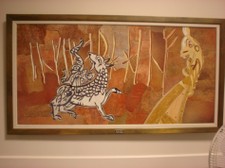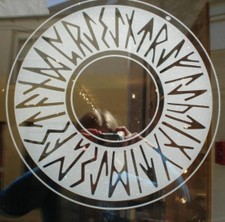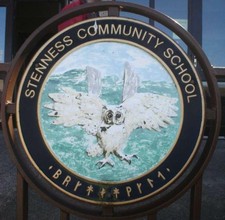Ancient script in our modern times
There are runes on local jewellery, food, knitwear, and other products.
But the modern use of runes in Orkney is not only restricted to displaying a “tourist identity” tailored to creating a sense of the exotic for visitors. Runes also play a genuine part in the resident local community, featuring for instance on local business logos, in schools, and in some cases tattooed on local people’s own bodies. I am sometimes asked by people to translate things into runes for them, for use in everything from wedding rings and tattoos to SWRI trophies. So runes clearly have a place in many people’s hearts, and I am planning to run an evening class in practical runology next winter.
So I thought it would be fun to go around and photograph as many runic texts as I could find around me here in Orkney. I started doing this several years ago, and when I had a chance I also tried to ask people why they had chosen to use runes. I recently had opportunity to present my finds to an international group of runologists, who found the wide variety of modern uses of runes in Orkney very fascinating.
So, where did I find all these modern runes, and what do they say?
Well, the text above the airport entrance says “krimsitir”. That means Grimsetter, the local place name. However, in Viking Age runes there is no letter “g” or “e”, so they used “k” and “i” instead. The runologist Professor Michael Barnes of University College London gave advise on the spelling and design of the runes for the opening of the new terminal building in 2002. Thankfully, later on the Norse people invented a way of writing “g” and “e”, so in later inscriptions we don’t see that particular spelling problem.
Inside the airport, there are also runes to be seen in one of the beautiful vinyl pictures decorating the walls. The one nearest to the check-in desk has a runic text reading “ingibjorg hin f”. This represents the beginning of perhaps the most famous of the Maeshowe inscriptions from the 12th century. The full inscription reads “Ingibjorg, hin fagra ekkja. Mǫrg kona hefi r farit lút inn hér. Mikill ofláti. Erlingr”.  That means “Ingibjorg, the fair widow. Many a woman has gonestooping in here. A great show-off. (Signed:) Erlingr.”
That means “Ingibjorg, the fair widow. Many a woman has gonestooping in here. A great show-off. (Signed:) Erlingr.”
Also, in the bus station there are vinyl pictures with runes. Here, we can read other messages originally from Maeshowe, such as: “Ingigerðr er kynæna in vænsta”. This one is sometimes presented by Maeshowe tour guides as “Ingigerðr is the most beautiful of women”, but Michael Barnes in his book on the Maeshowe runes prefers to translate it as “Ingigerðr is the most beautiful of ...” and leave the word “kynæna” untranslated, as it doesn’t really make sense.
Also represented in the bus station is the beautiful Maeshowe inscription number 20: “þessar rúnar reist sá maðr, er rúnstr er fyrir vestan haf, með þeiri øxi, er átti Gaukr Trandilssonr fyrir sunnan land” – which means “these runes were carved by the man most skilled in runes in the West Ocean with the axe that Gaukr Trandilsson owned in the south of the land [Iceland]”.
Faithful resemblances of Maeshowe inscriptions also feature on Ola Gorie’s silver jewellery, the above mentioned Ingibjorg inscriptions being one, and another being number 18, which translates as “Arnfinn Food carved these runes”. Ola Gorie also produces some more freely inspired runic designs, such as rings and brooches reading “Orkney” and “I love you”, and smaller pieces of jewellery with single runes on them.
 Sheila Fleet has taken more artistic liberty with her runic jewellery designs. She mixes runes from different varieties of the runic alphabet, along with a roman letter “v” to compensate for the runic alphabet lacking this letter. Runes are very noticeable as you approach the front door of Sheila Fleet’s shop on Bridge Street: The runic text in the circular design on the door, also featuring in jewellery, reads: “reflecting times past and present” in the English language. Other Sheila Fleet runic designs read “Orkney” or “Orkney Isles”, “dreams of everlasting love,” “Skaill,” and “real love transcends time”.
Sheila Fleet has taken more artistic liberty with her runic jewellery designs. She mixes runes from different varieties of the runic alphabet, along with a roman letter “v” to compensate for the runic alphabet lacking this letter. Runes are very noticeable as you approach the front door of Sheila Fleet’s shop on Bridge Street: The runic text in the circular design on the door, also featuring in jewellery, reads: “reflecting times past and present” in the English language. Other Sheila Fleet runic designs read “Orkney” or “Orkney Isles”, “dreams of everlasting love,” “Skaill,” and “real love transcends time”.
When I contacted Sheila Fleet to ask what inspires her about runes, she replied: “As a designer I use Runes very much with an artistic approach. I partly us them to convey a sort of hidden message by using the Runes letters in a twig-like pattern. It is not until they read my origination card that some people realize it is not just a letter it actually has a hidden message. I defi nitely use an artistic license and there are many more ways of using Runes in a modern way which reflects our rich past heritage.”
Runes decorate other Orkney products as well. A design which has proven popular among visitors and islanders alike is the knitted “Orkney” jumper by Judith Glue. The same runic design also features on other Judith Glue products such as badges, handbags and t-shirts. It was originally designed in 1985 and is still in production. The pattern literally says “urkniu”, but the strange spelling is again because the Viking age variety of the runic alphalet, know as the Younger Futhark, doesn’t have all the letters that we have in our Roman alphabet. So “u” here has to do several jobs: It is both “o” and “y”, so that “urkniu” actually means “Orkney”. No wonder the Norse people invented extra letters later!
The Orkney Fudge boxes bear a nonsensical inscription in the Elder Futhark, transliterating as rRkts.ufelp. An explanatory text on the back of the box states: “When the Vikings arrived in Orkney during the 8th century, they brought with them a unique form of writing – Runes. The word “Rune” derives from the Old Norse word meaning ‘secret writing’. An example of these Runes feature on the front of this box.” Like with Sheila Fleet’s jewellery, informing the customer that “rune” means “secret writing” or “secret message” adds interest to the product. The runes on the Orkney Fudge box are accompanied by a picture of the Ring of Brodgar in sunset, and the text “the sweet taste of the isles”. In combination, it communicates a sense of the exotic and of mystery.
Runes can also be seen in logos of local businesses, schools, clubs and societies. The Orkney Netball Association’s runic logo reads “promoting netball in Orkney”. The tour guiding business Discover Orkney’s logo reads, naturally, “discover Orkney”. And the Orkney Kidney Patient Association’s logo reads “OKPA” in runes. The runes on the sign of Orkneyinga Saga centre are, ironically, nonsensical.
One runic text that puzzled me for years was the Stenness Community School logo. It has a picture of an owl and some standing stones, and a text that first appeared to read “brkhohwklt”. This text did not make sense to me. But one day I suddenly saw the light. The confusion had come about because the “branches” have been attached too high up in the last four letters. Runic letters all consist of a vertical “stave”, with the addition of one or more “branches” going off to the right or left. The branches can be attached at the top or middle of the stave, and the position of the branch is very important for determining which letter it is. So attaching a branch too high up would be like writing “T” when you meant to write a “+” sign. When I realised what had happened in Stenness, and moved all the branches of the last four letters down to the middle position, and substituted what looks like a branch with a dot in the third last rune, the text suddenly made sense. The  text represents the end of one of the Maeshowe inscriptions. It says “brehøhþena” which is normalised Old Norse would be “bryti haug þenna”, which means “broke (into) this mound”. Whoever designed the logo must have taken the runes from James Farrer’s 1862 publication of the Maeshowe runes. Farrer didn’t realise that “broke this mound” was the continuation of the text that runs up the upright stone to the left of the entrance. At one point, the carved couldn’t reach any higher, and therefore continued horisontally, and perpendicularly to the rest of the text, on the next stone. Farrer thought these were two different messages, and published drawings of them separately. Farrer got some professors to look at the drawing and provide translations, including George Stephens, who got back with the following hilarious translation of the vertical bit of the text: “That man who sat here in ache (sorrowfully) He at the Fee-Ware (at the treasure-gate—from the treasure-guard) forth a broke, with three comrades from the stronghold broke forth the Hero Ænthaeir.” Professor Stephens comments: “This probably announces the escape of a prisoner, perhaps an Englishman”. 132 years later, Professor Michael Barnes realised that the bit on the next stone belonged to the same text, and made a much more believable, but still equally exciting translation: “'That will be true which I say, that treasure was carried away. Treasure was carried away three nights before they broke this mound.” Of this tantalizing message, the Stenness School logo repeats only the ending: “... broke this mound”.
text represents the end of one of the Maeshowe inscriptions. It says “brehøhþena” which is normalised Old Norse would be “bryti haug þenna”, which means “broke (into) this mound”. Whoever designed the logo must have taken the runes from James Farrer’s 1862 publication of the Maeshowe runes. Farrer didn’t realise that “broke this mound” was the continuation of the text that runs up the upright stone to the left of the entrance. At one point, the carved couldn’t reach any higher, and therefore continued horisontally, and perpendicularly to the rest of the text, on the next stone. Farrer thought these were two different messages, and published drawings of them separately. Farrer got some professors to look at the drawing and provide translations, including George Stephens, who got back with the following hilarious translation of the vertical bit of the text: “That man who sat here in ache (sorrowfully) He at the Fee-Ware (at the treasure-gate—from the treasure-guard) forth a broke, with three comrades from the stronghold broke forth the Hero Ænthaeir.” Professor Stephens comments: “This probably announces the escape of a prisoner, perhaps an Englishman”. 132 years later, Professor Michael Barnes realised that the bit on the next stone belonged to the same text, and made a much more believable, but still equally exciting translation: “'That will be true which I say, that treasure was carried away. Treasure was carried away three nights before they broke this mound.” Of this tantalizing message, the Stenness School logo repeats only the ending: “... broke this mound”.
So runes clearly play a part in representing Orkney to visitors, but just as important is the internal use of runes in the Orkney community. When pupils from Papdale Primary School made a tapestry with a picture Orkney for the international Golden Tapestry project, they chose to include the text “Papdale, Kirkwall, Orkney, Scotland” in runes. The tapestry now hangs on display in the school. One Orcadian man I know has “Orkney” tattooed in huge runes on his arm. I also had the good fortune to meet one out of a pair of Orcadian sisters, both of whom had runes tattooed on their wrist. The one I met had the text “ney”. When I asked her why she had “ney” in runes tattooed on her wrist, she explained that her sister has the other half of the text: “Ork”. Orcadians happily wear Judith Glue’s runic knitted jumpers and t-shirts. One day I caught convener Steven Heddle wearing such a t-shirt, and when I asked him about it, he explained to me: “It makes a talking point when I’m on holiday outside of Orkney. It gives me a chance to explain about Orkney’s history.” Do we detect a little pride in Orkney’s Norse history?
Runes function as a mark of difference, and as reminders of the past. They provide tourists with the sense of uniqueness that they seek, and locals with pride in Orkney’s history and heritage. We could end with George Mackay Brown: “Carve the runes. Then be content with silence.”